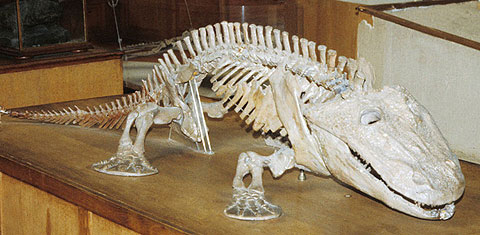|
Body Armor for Breathing?
 |
Bony fellow. The large amounts of dermal bone in early tetrapods such as Eryops, a 1.5-meter-long, semi-aquatic amphibian (fossil shown) that lived about 295 million years ago, could have helped such creatures deal with acidic blood caused by inefficient lungs.
Credit: Christine M. Janis
|
Many of the earliest four-legged creatures that ventured onto land were heavily armored beasts, sporting plates of bone beneath their skin. This "dermal bone" might have protected their blood vessels and nerves while keeping these so-called tetrapods warm and hydrated. Now researchers have come up with a possible new function for the material: It may have prevented the animals' blood from turning to acid.
"Nobody's suggested this before, but it certainly seems plausible," says Jennifer Clack, a vertebrate paleontologist at the University of Cambridge in the United Kingdom, who was not involved in the work.
One of the biggest challenges of life on land is getting rid of your carbon dioxide. All we have to do is exhale—but early land dwellers, many of which were semi-aquatic amphibians, had primitive lungs. And unlike us, their ribs were fixed in place, making it hard to breathe in and out. As a result, carbon dioxide could have easily built up in their blood, acidifying it—especially after they chased prey or escaped predators.
Dermal bone may have solved this problem. For instance, when turtles spend a long time underwater holding their breath, there's no intake of oxygen to displace the carbon dioxide that slowly builds in their blood. To compensate, the dermal bone in their shell leaches calcium and magnesium ions into their bloodstream, replacing the acidic hydrogen ions that have built up there.
Dermal bone in early tetrapods could have served a similar purpose, says Christine Janis, a vertebrate paleontologist at Brown University. To bolster her case, she and colleagues analyzed a trove of early tetrapod fossils. The team found that, as a general rule, big creatures, whose tissues would have produced large amounts of carbon dioxide, had prodigious amounts of dermal bone. Meanwhile, small creatures, which likely could have rapidly lost carbon dioxide through their skin—as many of their wee modern relatives, such as some salamanders, do—had little if any dermal bone. Also, as the team reports online today in the Proceedings of the Royal Society B, creatures thought to be fully aquatic and, therefore, have efficient gills to rid themselves of carbon dioxide, such as the 1-meter-long Whatcheeria, had little dermal bone. On the other hand, the similar-sized Pederpes, which spent more time out of water, had larger amounts of dermal bone.
Janis admits that the findings are just a correlation. "This is only speculation, but it's fairly solid," she says. But if true, dermal bone could have been a life-saver for tetrapods. At the very least, she says, "it would have bought them time on land."
Source: ScienceNOW
24/04/2012
|